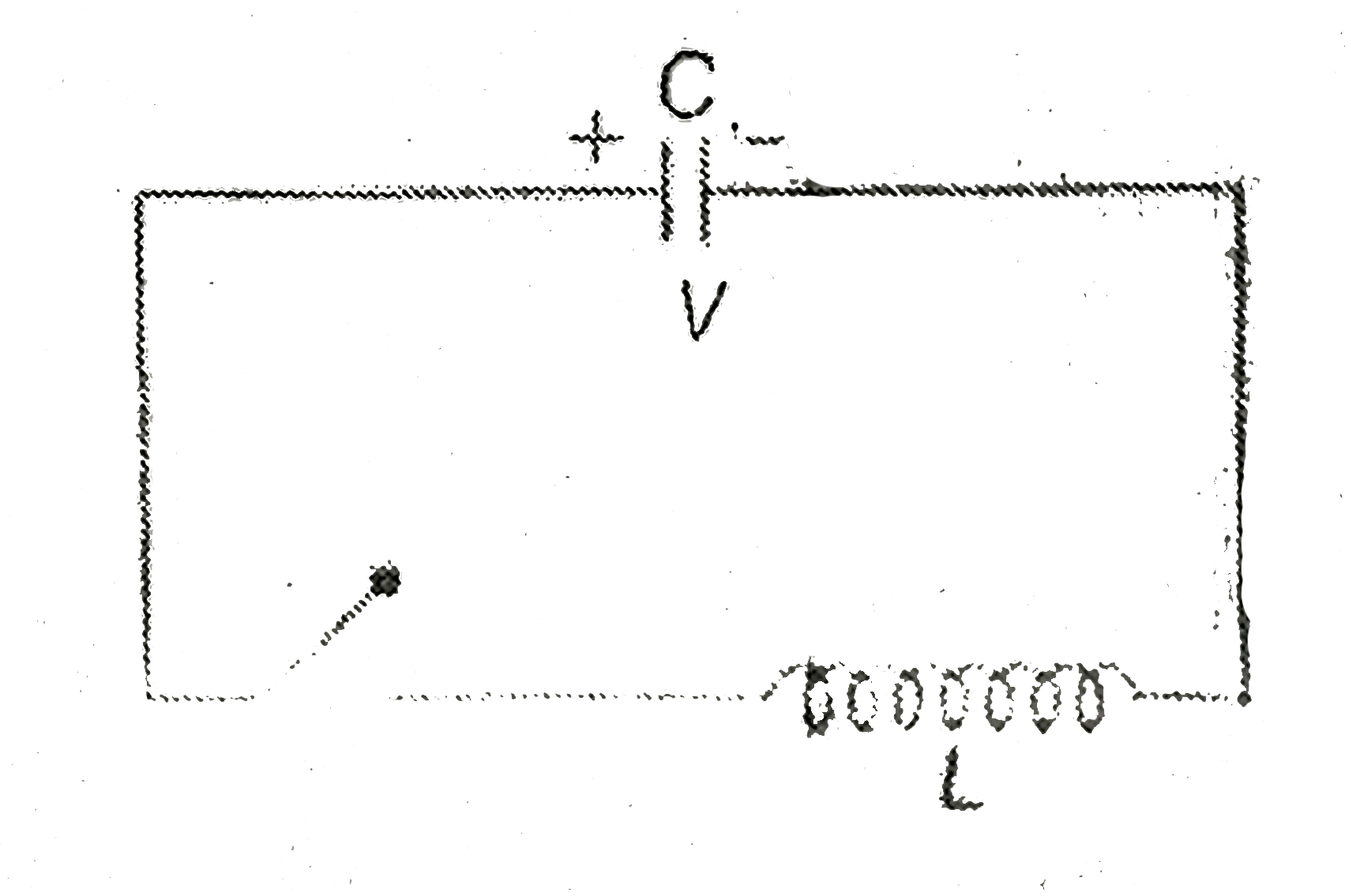A capacitor of capacitance C0 is charged to a patential V0 and then isolated. A small capacitor C is then charged from C0, discharged and charge again, the process being is decreased to V. Find the value of C.
The correct Answer is:C0⎡⎣(V0V)1n−1⎞⎠⎤⎦
To solve the problem step by step, we need to analyze the charging and discharging process of the capacitors involved.
Step 1: Initial Charge on Capacitor C₀
The initial charge Q0 on the capacitor C0 when charged to a potential V0 is given by the formula:
Q0=C0V0
Step 2: Charge Transfer to Capacitor C
When the small capacitor C is charged from C0, the charge on C after the first charging process can be expressed as:
Q1=C0C+C0Q0
Substituting Q0:
Q1=C0C+C0(C0V0)=C20V0C+C0
Step 3: Potential After First Charging
The potential V1 across the capacitor C after the first charging process can be calculated using:
V1=Q1C=C20V0C(C+C0)
Step 4: Repeating the Process
If we repeat the charging and discharging process n times, we can express the potential after n processes as:
Vn=C20C+C0Vn−1
Continuing this process, we find that:
Vn=(C0C+C0)nV0
Step 5: Setting the Final Potential
According to the problem, after n processes, the potential decreases to V:
V=(C0C+C0)nV0
Step 6: Rearranging the Equation
Rearranging the equation gives:
C0C+C0=(VV0)1n
Step 7: Solving for C
Cross-multiplying and rearranging to isolate C:
C0=(VV0)1n(C+C0)
C0=(VV0)1nC+(VV0)1nC0
C0−(VV0)1nC0=(VV0)1nC
C0⎛⎝1−(VV0)1n⎞⎠=(VV0)1nC
Finally, solving for C:
C=C01−(VV0)1n(VV0)1n
Final Result
Thus, the value of C is:
C=C0(V0V−1)
The initial charge Q0 on the capacitor C0 when charged to a potential V0 is given by the formula:
Q0=C0V0
When the small capacitor C is charged from C0, the charge on C after the first charging process can be expressed as:
Q1=C0C+C0Q0
Substituting Q0:
Q1=C0C+C0(C0V0)=C20V0C+C0
The potential V1 across the capacitor C after the first charging process can be calculated using:
V1=Q1C=C20V0C(C+C0)
If we repeat the charging and discharging process n times, we can express the potential after n processes as:
Vn=C20C+C0Vn−1
Continuing this process, we find that:
Vn=(C0C+C0)nV0
According to the problem, after n processes, the potential decreases to V:
V=(C0C+C0)nV0
Rearranging the equation gives:
C0C+C0=(VV0)1n
Cross-multiplying and rearranging to isolate C:
C0=(VV0)1n(C+C0)
C0=(VV0)1nC+(VV0)1nC0
C0−(VV0)1nC0=(VV0)1nC
C0⎛⎝1−(VV0)1n⎞⎠=(VV0)1nC
Finally, solving for C:
C=C01−(VV0)1n(VV0)1n
Thus, the value of C is:
C=C0(V0V−1)
Topper's Solved these Questions
- CAPACITOR AND CAPACITANCEBook:CENGAGE PHYSICS ENGLISHChapter:CAPACITOR AND CAPACITANCEExercise:Single Correct
Explore 49 Videos
- CAPACITOR AND CAPACITANCEBook:CENGAGE PHYSICS ENGLISHChapter:CAPACITOR AND CAPACITANCEExercise:Multile Correct
Explore 11 Videos
- CAPACITOR AND CAPACITANCEBook:CENGAGE PHYSICS ENGLISHChapter:CAPACITOR AND CAPACITANCEExercise:Exercise 4.2
Explore 32 Videos
- ATOMIC PHYSICSBook:CENGAGE PHYSICS ENGLISHChapter:ATOMIC PHYSICSExercise:ddp.4.3
Explore 15 Videos
- CENGAGE PHYSICS DPPBook:CENGAGE PHYSICS ENGLISHChapter:CENGAGE PHYSICS DPPExercise:subjective type
Explore 51 Videos
Similar Questions
A capacitor of capacitance C0 is charged to potential V0. Now it is connected to another uncharged capacitor of capacitance C02. Calculate the heat loss in this process.
View SolutionA capacitor of capacitance C1 is charged to a potential difference V and then connected with an uncharged capacitor of capacitance C2 a resistance R. The switch is closed at t = 0. Choose the correct option(s):
View Solution
Knowledge Check
A capacitor or capacitance C1 is charge to a potential V and then connected in parallel to an uncharged capacitor of capacitance C2. The fianl potential difference across each capacitor will be
AC1VC1+C2BC2VC1+C2C1+C2C1D1−C2C1
A capacitor of capacitnace C is charged to a potential difference V and then disconnected from the battery. Now it is connected to an inductor of inductance L at t=0. Then

View SolutionA capacitor of capacitance C is charged to a potential differece V0. The terminals of the charged capacitor are then connected to those of an uncharged capacitor of capacitance C/2.
a. Compute the original charge of the system.
b. Find the final potential differce across each capacitor.
c. Find the final energy of the system.
d. Calculate the decrease in energy when the capacitors are connected.
e. Where did the ''lost'' energy go?
View SolutionA capacitor of capacitance C1 is charged to a potential V1 while another capacitor of capacitance C2 is charged to a potential difference V2 . The capacitors are now disconnected from their respective charging batteries and connected in parallel to each other .
(a) Find the total energy stored in the two capacitors before they are connected.
(b) Find the total energy stored in the parallel combination of the two capacitors.
(c ) Explain the reason for the difference of energy in parallel combination in comparison to the total energy before they are connected.
View SolutionA capacitor of capacitance C is charged to a potential difference V0 and then connected with a resistance and a battery of EMF 3V0 such that the positively charged plate of the capacitor is connected to the positive terminal of the battery. The total heat generated in the resistance until the current in the circuit becomes zero is n(CV20). the value of n is ________.
View SolutionA capacitor of capacitance C is charged to a potential V. The flux of the electric field through a closed surface enclosing the capacitor is
View SolutionA capacitor of capacitance 5μF is charged to potential 20V and isolated. Now, an uncharged capacitor is connected in parallel to it. If the charge distributes equally on these capacitors, find total energy stored in capacitors.
View SolutionA capacitor of capacitance C is charged to a potential difference V0. The charged battery is disconnected and the capacitor is connected to a capacitor of unknown capacitance Cx. The potential difference across the combination is V. The value of Cx should be
View Solution